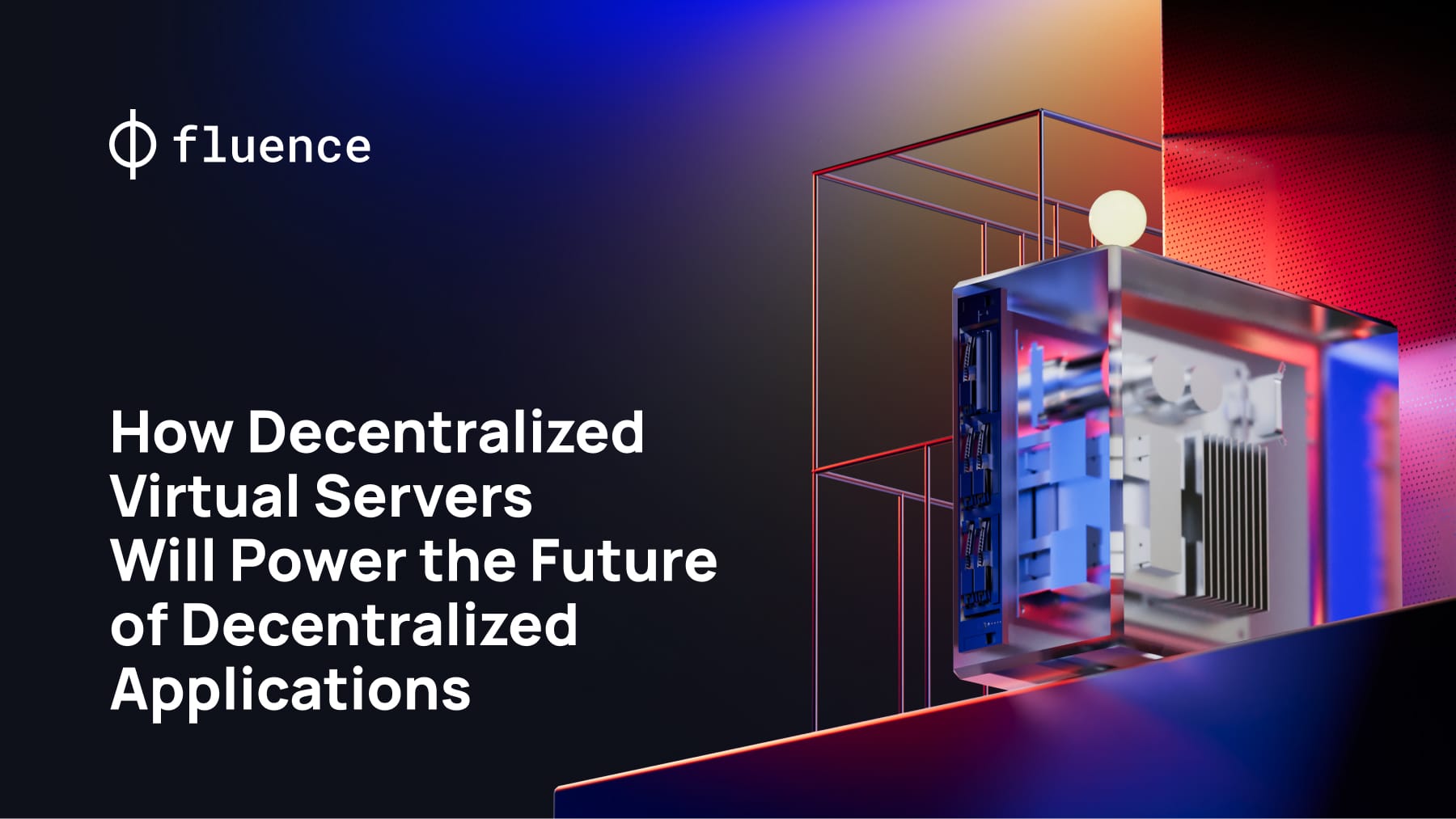How Decentralized Virtual Servers Will Power the Future of Decentralized Applications (dApps)
Decentralized virtual servers for dApps offer scalable, trust-minimized compute. This article explains their role, use cases, and how Fluence fits into the shift.

The global Web3 market is growing at a compound annual rate of 49.3% over the next five years, supported by rising demand for user-centric, trustless platforms and systems designed to reduce centralized control. This surge is not centered solely on token speculation or DeFi activity; it reflects a broader change in how applications are built, deployed, and scaled. A foundational infrastructure element enabling this change is the decentralized virtual server.
These distributed compute environments are reshaping how decentralized applications (dApps) function by giving them the flexibility, scalability, and programmability associated with traditional cloud-native apps—without relying on centralized systems.
This article outlines how decentralized virtual servers support the future of dApps through technical architecture, real-world use cases, and deployment strategies.
Market Growth and Strategic Timing
The decentralized application development sector is expected to expand from $25.63 billion in 2022 to $70.82 billion by 2030, growing at a CAGR of 56.1%, according to Virtue Market Research. This growth reflects increased demand for more efficient transactions, lower infrastructure costs, and transparent architecture.
Meanwhile, the supporting Web3 infrastructure has reached wider visibility. Ethereum operates a global network of over 400,000 nodes, and technologies like Layer 2 scaling, modular chains, and decentralized data storage are already in use. Distributed compute solutions like Fluence Network represents the next technical tier to see real-world uptake.
Developers adopting decentralized compute early may benefit from lower infrastructure expenses, fewer compliance concerns, and enhanced user trust. As application complexity rises, centralized cloud setups may become a bottleneck—technically and operationally.
The Limitations of Traditional Cloud for dApps
Traditional cloud infrastructure—centralized, proprietary, and regionally siloed—creates friction for dApp developers. Friction points include:
- High cost: Established cloud providers charge premium rates that strain the budgets of early-stage Web3 ventures.
- Limited crypto support: Many platforms impose restrictions or outright bans on blockchain and decentralized application workloads, forcing Web3 teams to seek workarounds.
- Vendor lock-in: Migrating workloads between platforms can be difficult, especially for applications with persistent state and complex logic.
These limitations undermine Web3 principles such as decentralization, trust minimization, and resistance to censorship. As dApps extend beyond smart contracts into full-stack applications with frontends, backends, and data operations, decentralized compute infrastructure is becoming essential. Chief among them? Decentralized virtual servers.
Decentralized Virtual Servers: What They are and Why They Matter
Decentralized virtual servers deliver virtual compute instances by pooling resources from top-tier data centers, with allocation and management governed through on-chain smart contracts.
Key characteristics include:
- Permissionless provisioning: Workloads can be deployed by any user without reliance on centralized authorities.
- Cryptographic verification: Provisioned capacity is verified using on-chain validation or zero-knowledge proofs.
- Incentive-aligned resource allocation: Operators are compensated through token mechanisms or micro-payments.
- Stablecoin payments: Usage fees are settled in stablecoins, ensuring predictable costs and minimizing currency volatility.
An increasing number of dApps are beginning to explore decentralized virtual servers, but the options that are able to provide both cost-efficiency and true scalability are limited. But one that is racing ahead of the pack is Fluence Network.
Fluence’s Cloudless Virtual Servers: Addressing Decentralized Compute Challenges
Adopting decentralized virtual servers presents technical and organizational hurdles, but the ecosystem is rapidly evolving. Platforms like Fluence Network are actively solving key issues around cost, usability, performance, and trust to make decentralized compute practical and scalable.
Fluence offers decentralized virtual servers at up to 75% lower cost than traditional hyperscalers—expanding access for dApp developers and enabling sustainable incentives for independent node operators. This economic model supports long-term network growth and reliability.
To reduce developer friction, Fluence provides streamlined tooling through its user-friendly console to simplify deployment and orchestration of distributed apps. It also meets the performance demands of workloads like AI inference by aggregating global compute capacity, including access to enterprise-grade hardware, and soon (in the near future) to GPUs.
Security and trust are ensured through built-in cryptographic verification, aligning with Web3 principles and enabling compute capacity provenance without centralized intermediaries.
Why dApps Need Decentralized Compute
Smart contracts manage deterministic logic and on-chain state but can’t handle intensive processing, off-chain computation, or frontend rendering. Decentralized virtual servers expand technical capabilities through:
- Backend logic execution: APIs, aggregators, and microservices can run off-chain while remaining decentralized.
- AI and ML inference: GPU-equipped decentralized instances support machine learning inference for AI-enhanced applications.
- Frontend hosting: React, Vue, or Svelte web interfaces can be served from decentralized instances, using storage systems like IPFS or Arweave.
For instance, protocols such as Serum and GMX rely on responsive off-chain order books and real-time price feeds. Hosting these services on decentralized virtual servers improves performance and aligns with trustless infrastructure principles.
Real-World Use Cases
Several ongoing projects are already deploying or exploring decentralized virtual servers today:
- Decentralized AI Inference: Projects like Gensyn and Bittensor operate decentralized machine learning networks. Their operations require GPU-intensive servers and verifiable processing.
- Decentralized Gaming: Games such as My Neighbor Alice and Illuvium are developing real-time multiplayer features. Decentralized servers host matchmaking, game logic, and in-game physics engines, improving accessibility and reducing dependence on centralized tech stacks.
- Supply Chain dApps: Platforms including OriginTrail process and verify geographically distributed data with persistent compute environments designed for auditability and compliance.
- Virtual Real Estate and Metaverse: Platforms like Decentraland and The Sandbox need permanent virtual spaces capable of handling interactive experiences and supporting content created by users. These capabilities are sustained by decentralized virtual servers.
- Insurance and Oracles: Projects such as Nexus Mutual and Chainlink conduct aggregate data processing off-chain. Moving these operations to decentralized infrastructure boosts reliability and avoids centralized chokepoints.
These examples demonstrate benefits such as stronger availability guarantees, access control decentralization, and enhanced fault tolerance. Applications that adopt distributed infrastructure through IPFS or Arweave already experience better resilience and data protection.
Strategic Implications: A Systems Thinking Perspective
Decentralized virtual servers act as a critical node across the Web3 technology spectrum. They create reciprocal connections between users, builders, and infrastructure providers. These interactions build stronger networks over time and help distribute cost and performance gains.
Computing resources managed by independent participants also help distribute risk, drive innovation by region, and scale development capacity. The model mirrors a broader shift in computing history—from centralized mainframes through cloud services and now to globally distributed compute networks.
Applications running on decentralized virtual servers no longer depend exclusively on cloud monopolies. Instead, they tap into open ecosystems that prioritize transparency, decentralized logic, and permissionless deployment.
Conclusion
Decentralized virtual servers already support functional dApps across sectors including finance, machine learning, gaming, and supply chains. As Web3 infrastructure matures, these servers are becoming a viable and stable compute option that can support full-stack applications without falling back on centralized hosting models.
For teams building dApps that value long-term control, transparency, and trust minimization, decentralized virtual servers offer a technically sound and strategically aligned compute path.
Start integrating decentralized compute into your dApp architecture today with Fluence Virtual Servers.

